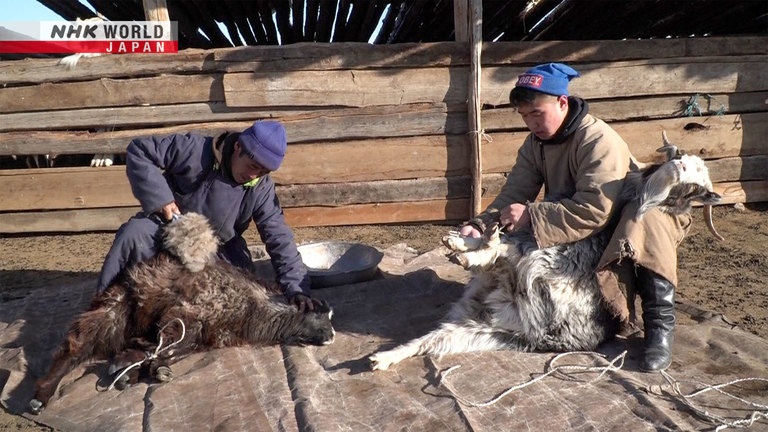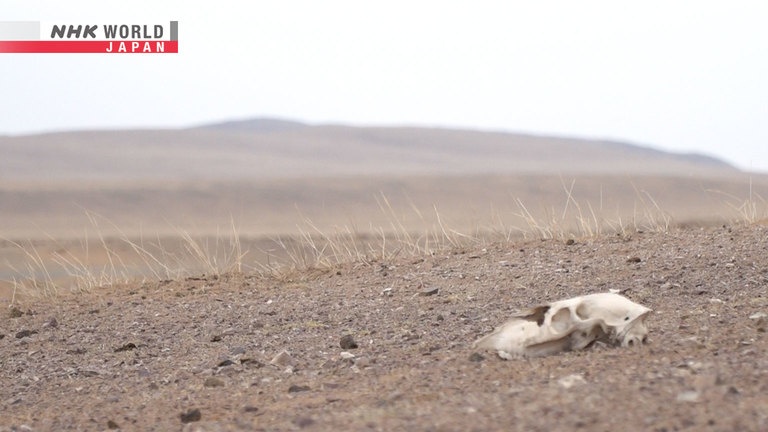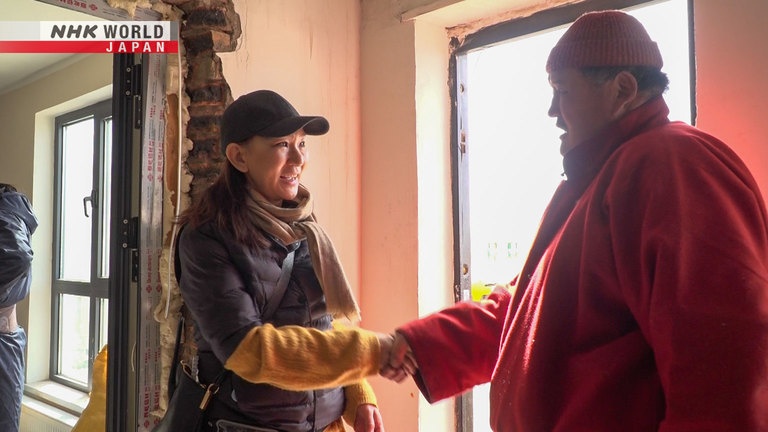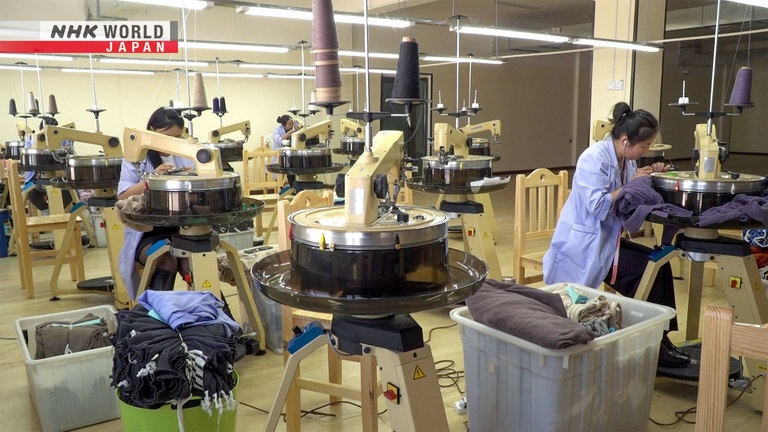Shaping Sustainable Cashmere: Mongolia
Mongolia's nomads are raising an increasing number of cashmere goats. The goats' soft undercoats provide the raw wool for luxury cashmere fabric, and is an important cash income. But this rise has also triggered serious environmental problems. Because goats pull grass out by the roots when grazing, nearly 80% of Mongolia's land is threatened by desertification. We follow the NPOs, companies and nomads working to restore the plains, and realize a higher standard of living.




Transcript
The highlands of western Mongolia.
This is the home of Mongolia's nomads and their vast herds of sheep and goats.
In the past, most only raised sheep, but in recent years the number of cashmere goats has soared.
Today there are around 28 million of them, a seven-fold increase over fifty years.
Cashmere goats inhabit the mountains of Asia, where temperatures vary enormously.
To keep warm through the harsh winter, they grow a soft, fine undercoat below their surface guard hair.
This soft down is the raw material used in high-grade cashmere products.
It's a precious source of cash income for nomads.
But the sharp rise in cashmere goats has led to significant problems.
The goats pull grass out by the roots when grazing.
Nearly 80% of Mongolia's land now faces desertification.
Two things drive this desertification.
The first is climate change.
The second is the rise in goats.
That's the biggest cause.
The search is on to find a way to grow the cashmere industry while protecting the grasslands.
One NPO that specializes in cashmere is urging nomads not to increase their flocks.
Instead, they can enhance their income by raising the goats in a way that improves the wool's quality.
The nomads live alongside their herds
in the most organic surroundings.
I want the world to know
what they make here.
One manufacturer is taking on the entire production line,
from buying the wool to crafting quality cashmere products to sell to the global market at a profit.
They plan to return this extra profit to the nomads.
Meet the people looking to conserve Mongolia's environment and drive sustainable cashmere for a brighter future.
Ulziit in Arkhangai province, lies to the west of Mongolia's capital, Ulaanbaatar.
This is Gaansukh, a nomad.
He owns a herd of 200 cashmere goats.
He bred the numbers up from a herd of 30 over a period of twenty years.
His son, Ganzorig is a 2nd-year student at a university in Ulaanbaatar.
He's taken time off to come home and help harvest the goats' undercoats.
Bring the comb.
The delicate undercoat from which cashmere is made can only be harvested between April and May,
when the worst of the winter weather has calmed.
This is cashmere.
A single goat provides just 300g of undercoat.
This scarcity makes it extremely valuable, to the point that cashmere is sometimes called 'soft gold'.
The down must be combed out by hand, so it takes 30 minutes to harvest from one animal.
A herd of 200 means days of work.
Gaansukh continues to improve his yield each year, but life remains full of hardships.
It's Saturday, which is watering day.
But the motor to pump water
from the well is broken.
I paid 57 US dollars to repair it
but it's broken again.
I've just sold cashmere so I can
pay off my debts, now this.
Every time. There's big money,
but it never stays with me.
Gaansukh has significant debts to the bank and acquaintances.
His son's education is costly, but his biggest expense is feeding the animals.
The shrubs and grasses that were plentiful on the grasslands have vanished over the last decade.
Today he needs to buy meal, hay, and other animal feed.
There was long grass everywhere
when I was a boy.
So thick you couldn't see through it.
It's totally different now.
Nobody bought feed for their animals.
Grazing was more than enough.
Gaansukh owns 600 cows and horses in addition to his 200 goats.
Feeding them all takes time and labor.
There's a building in the village where nomads often gather.
This is the nomads' cooperative association.
It's called 'Horshoo', meaning 'buyers'.
The co-op buys the nomads' wool and sells it wholesale to domestic and Chinese manufacturers.
106kg.
The market rate is around 40 dollars for a kilogram of raw cashmere.
This amount is worth over four thousand dollars.
Payment can be in cash or via bank transfer, whichever the seller prefers.
Just one.
Today, Gaansukh is visiting the co-op.
He has wool from 30 goats, which took the whole family a full day to harvest.
- Exactly 10kg?
- 10.7kg.
- From yesterday?
- No, today.
-Any later and it'd be guard hair.
-Is there some mixed in?
- Shall I take off the cost of feed?
- Yes, please.
The sale comes to 420 dollars.
But after subtracting an earlier loan for animal feed, Gaansukh receives just 340 dollars.
Now, he must pay off his bank and personal loans.
I'll have to sell off livestock
this summer to pay off the loans.
The animals have supported the family for generations.
But his son Ganzorig understands it's the only option.
I might take over from my father.
But I don't know yet.
Many nomads have trouble making ends meet, even after increasing their income through cashmere.
The rapid desertification of the highlands has forced many to turn away from traditional lifestyles and move to the city.
The town of Emeelt lies 50 kilometers southeast of capital Ulaanbaatar.
It's an enormous hub for cashmere.
Mongolia produces nearly ten thousand tons of raw cashmere wool in a year.
The market is worth some 400 million dollars.
But only 20% of that is turned into high-end fabric, clothes, accessories, or other profitable products.
The remaining 80% is exported raw to China.
Mongolia's nomads made their own clothing out of cashmere for centuries.
After the country was democratized in the late 20th century, global demand for cashmere soared.
But the political instability caused widespread turmoil for years.
The industrial technology to make cashmere products never arrived, and there was no funding to build factories.
Today there are many factories to wash the raw wool, but few that can also spin and weave it.
The bulk of the raw wool simply cannot be turned into profitable products.
One expert at Mongolia's state university has spent years researching cashmere.
To double or triple cashmere sales
we need to reduce raw exports.
We must turn 80% of it into products
before it leaves Mongolia.
One Ulaanbaatar manufacturer has already started doing this,
taking on the entire process from buying wool to producing complete products.
It's called SOR Cashmere.
Their factory strictly regulates humidity and temperature.
The washed wool has any remaining impurities removed so only the softest, highest-quality fibers remain.
There are currently 130 staff here.
The firm makes and supplies sweaters, dresses, and other items to the domestic market as well as China, the US, and Europe.
It's headed by Erdenetuya.
Today, she's guiding loan officers from the World Bank on an inspection tour.
Erdenetuya and her husband opened a raw cashmere store in Ulaanbaatar 30 years ago.
After receiving an enormous order from a French tourist,
they delivered their cashmere to France, where they were inspired to establish their current firm.
Other countries make beautiful
things from Mongolian cashmere.
Why can't we make those ourselves?
I felt we should be creating
Made in Mongolia products.
Erdenetuya buys wool at the highest price she can.
She wants to direct the revenue from her profitable cashmere products back to the nomads.
Mongolians raise their animals
with great care.
I want to use this beautiful cashmere
to make wonderful products.
They're the reason I was able to grow
this firm to its current size.
We're all in the same boat.
A new certification system called the SFA is looking to increase nomads' income and make a push into the global market.
It highlights sustainable, ethical, high-quality cashmere products from Mongolia.
NPO Sustainable Fibre Alliance manages the certification system.
These are their Ulaanbaatar headquarters.
SFA founder Batkhishig.
She has a US doctorate in rangeland ecosystem science.
After returning to Mongolia, she began visiting pasturelands to research the changes in nomad life and the environment.
Alarmed by the rapid desertification of the highlands, she launched the SFA in 2015.
Consumers, manufacturers, and nomads
need a certification they can trust.
A shared awareness and embrace
of these new standards.
That will help us get a foothold
in the global market.
Nomads, co-ops, manufacturers, and anyone involved in the industry is eligible for certification.
To achieve it, they must meet the SFA's strict requirements.
To help foster understanding of these requirements, the group holds regular training sessions.
These are teaching materials for nomads.
They cover techniques for raising goats, combing their wool, and storing and transporting it.
There are concrete rules for various steps.
The entire certification system has over 230 requirements.
The co-ops ensure the nomads' certified wool is processed by certified factories.
The fibers are inspected for width and length, and only the best quality cashmere is used to make certified thread and clothing.
The SFA also has an office in London that links SOR Cashmere and other Mongolian manufacturers to Western firms.
The group operates on membership fees paid by these companies.
Nomad Amgalambaator received SFA certification two years ago.
He follows the strict requirements when caring for his animals and harvesting wool.
A clean sheet is always laid down before anything is combed.
This prevents dirt and dust getting into the fibers.
We start with a large comb
to prevent tangling.
Then remove any guard hair.
The SFA makes the most of the nomads' traditional expertise.
I built this fence with SFA guidance.
No metal, string, or nails.
It's a traditional approach.
Rain and snow cause nails to rust quickly.
Fences with nails soon fall apart and can injure animals.
Fences that use only timber are sturdier and safer.
Hay for animal feed is suspended from ropes to keep it clean.
When placed in hay boxes, it can be contaminated by dirt, dust, and droppings, and the goats will stop eating it.
Prices for Amgalambaator's wool have increased and stabilized since being SFA certified.
He is delighted.
SFA regulations aren't difficult.
They're interesting, and I want to learn more.
We want to work hard and teach
our children to do the same work.
I think we can survive as nomads.
To date, the SFA has certified 10,000 nomad groups, and a hundred co-ops.
Since its founding, the SFA has engaged with another major issue: desertification.
A vital part of the certification system is the scheduled use of pastureland.
After consultation with local nomads and co-ops, the pastureland has been divided up.
Each area is designated off-limits in rotation, to give the land time to recover.
But unless nomads can earn a stable income without growing their herds, it will be an uphill battle.
The SFA is urging nomads and co-ops across Mongolia to seek certification and increase their profits from raw wool.
Many nomads have little interest in the SFA.
They continue to raise their animals as they've always done.
Today Batkhishig is visiting a nomad family to explain the certification system.
It's a one-hour drive from Ulaanbaatar, in the Altanbulag region.
Together with his wife and three children, veteran nomad Ulziibayar raises 1300 animals, including 400 cashmere goats.
He shows Batkhishig his livestock.
Kid goats roll around on the ground, which is covered in dung.
It's even in the feed boxes.
Nails stick out from the wooden fence.
A quick glance is enough to see that there is room for improvement.
But Batkhishig doesn't immediately assail them with a list of changes.
This is the fruit of very hard
work, which I deeply respect.
Every material had to be
brought here and built by hand.
His dedication is in every nail,
every piece of wood.
Ulziibayar invites the group into his home.
Batkhishig founded the SFA
for sustainable cashmere.
She gives advice to people.
She has a PhD.
Knows much more than us!
That can't be true!
After years studying from nomads
I've finally learned a little.
Batkhishig has visited over 300 villages around Mongolia and met many nomads.
More than a few were dismissive of the SFA system.
There's a lot of talk of
animal rights these days.
Do animals have rights?
We take their cashmere in cold March!
Maybe consider not taking it
while it's still very cold.
The group watches the cashmere being harvested.
The goat's horns are tied to a rope, and it thrashes about unhappily.
Tying them tightly can harm them.
Is it necessary?
Batkhishig's gentle request persuades them to loosen the rope.
May I try myself?
Comb the white section.
This part too.
Brush hard to get it out.
The rest we remove with a fine comb.
Batkhishig doesn't press her ideas on her hosts.
Instead, she raises topics of mutual interest to promote healthy communication.
Cashmere clothes can be washed with
cold water and shampoo. Like hair.
Really?
The color of your cashmere
is number three.
It's a good white?
They're all good colors.
All beautiful.
He seems willing to embrace Batkhishig's aspirations for better quality raw wool.
I want to raise cashmere goats with
a better understanding of quality.
I'd like to improve
and sell finer cashmere.
Before they part, Ulziibayar lets Batkhishig ride one of his horses.
He also agrees to meet her again soon.
It was a promising meeting.
If he understands our standards
we can move forward each year.
We also need to understand the
unique demands of each region.
Gaansukh still has loans from needing to buy animal feed.
A friend suggested he take part in an SFA training seminar.
Desertification is getting bad.
We won't be able to graze soon.
Then I'd have to sell my animals.
I'd love to see fat animals grazing
in the summer.
Ignoring us and seeking out their own food.
Wandering the pasturelands at will.
I'd love to be watching over them
from a distance.
Mongolians are taking up the challenge of regenerating the grasslands, and establishing a sustainable cashmere industry.
It's a long journey towards a brighter future.